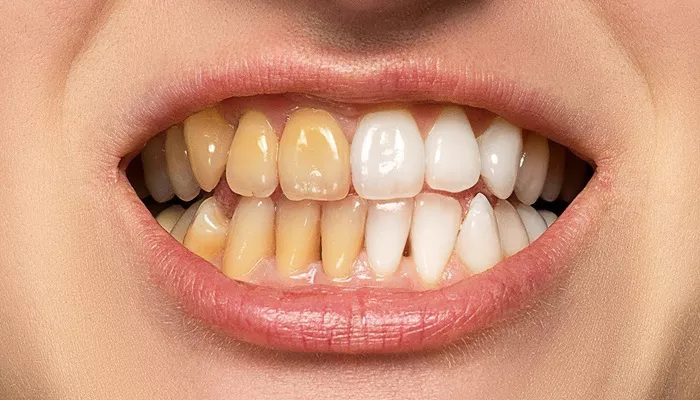Teeth whitening is a popular cosmetic procedure designed to enhance the brightness and overall appearance of one’s smile.
While many individuals achieve the desired result of a whiter smile, others may notice an unexpected outcome: their teeth appear more yellow following the whitening process. This phenomenon can be disheartening and puzzling for patients who have invested time and money into achieving a brighter smile. Understanding why teeth may look more yellow after whitening involves exploring the underlying causes, the nature of teeth whitening products, and the role of oral health in achieving and maintaining the desired results. This comprehensive article delves into these factors to provide a clearer picture of why teeth may look more yellow post-whitening and offers guidance on how to address and rectify this issue.
The Role of Whitening Agents
Whitening agents work by breaking down the chemical bonds of stains on the teeth. However, this process can sometimes affect the teeth’s color in ways that are not immediately apparent. The effectiveness of these agents depends on several factors, including the concentration of the active ingredients, the duration of application, and the presence of certain dental conditions.
Reasons Why Teeth May Appear More Yellow After Whitening
1. Initial Dehydration
One common reason for teeth appearing more yellow after whitening is dehydration. During and immediately after the whitening process, the teeth can become temporarily dehydrated. This dehydration can cause the enamel to appear more translucent and make underlying dentin more visible. Dentin is naturally darker than enamel, and when the enamel is less opaque, the dentin’s color can show through, giving the teeth a yellowish hue.
2. Ineffective Whitening Results
Not all whitening treatments yield the same results for every individual. Factors such as the type of stains, the original color of the teeth, and the strength of the whitening agent can impact the effectiveness of the treatment. If the whitening process does not address all types of stains equally, some discoloration may remain, leading to a less uniform appearance that might appear yellow.
SEE ALSO: How to Get Yellow Stains Out Between Teeth
3. Post-Whitening Sensitivity
After whitening, some individuals experience heightened tooth sensitivity. This sensitivity can cause the teeth to react differently to various foods and drinks, potentially leading to a perception of increased yellowing. Additionally, if the whitening treatment causes damage to the enamel, it can affect the overall appearance of the teeth.
4. Inconsistent Whitening Application
In-office whitening treatments are typically more controlled and uniform than at-home kits or over-the-counter products. Inconsistent application of whitening agents, whether due to improper use of at-home products or uneven coverage in professional treatments, can result in patchy whitening effects. These inconsistencies can sometimes make certain areas of the teeth look more yellow compared to others.
5. Residual Stains and Plaque
After whitening, it is essential to maintain good oral hygiene to prevent new stains from forming. If plaque and residue are not effectively cleaned from the teeth, they can contribute to an uneven appearance. Residual stains or plaque buildup can cause some areas of the teeth to look darker or more yellow compared to others.
6. Natural Variations in Tooth Color
Natural tooth color can vary significantly from person to person. Even with whitening treatments, some individuals may have teeth that naturally lean towards a yellow or grayish hue. In such cases, whitening may not achieve the desired shade of white, and the natural color variations can become more apparent.
Preventive Measures And Solutions
1. Proper Post-Treatment Care
To address and prevent yellowing after whitening, it is crucial to follow proper post-treatment care. This includes avoiding foods and beverages that can stain the teeth, such as coffee, tea, and red wine, for at least 48 hours after treatment.
Additionally, maintaining good oral hygiene by brushing and flossing regularly helps prevent plaque buildup and the formation of new stains.
2. Regular Dental Check-ups
Regular dental visits are essential for maintaining optimal oral health and achieving the best results from whitening treatments. Dentists can provide professional cleanings to remove plaque and tartar, assess the condition of the teeth, and offer personalized advice on maintaining a bright smile.
3. Choosing the Right Whitening Product
Selecting the appropriate whitening product or treatment is vital for achieving the best results. Consulting with a dental professional to determine the most suitable whitening method based on individual needs and dental health can help avoid undesired outcomes.
4. Addressing Dental Issues
If yellowing persists or worsens, it is important to address any underlying dental issues. Conditions such as enamel erosion, dental decay, or gum disease can affect the appearance of the teeth and may require treatment before or in conjunction with whitening procedures.
5. Using Desensitizing Products
For individuals experiencing sensitivity after whitening, using desensitizing toothpaste or gels can help alleviate discomfort and protect the teeth. These products can also help minimize the risk of uneven whitening results due to sensitivity.
Conclusion
Experiencing a yellowish appearance in teeth after whitening can be distressing, but understanding the possible causes can help address and manage the issue effectively. By considering factors such as dehydration, the effectiveness of the whitening treatment, post-whitening sensitivity, and natural tooth color variations, individuals can take informed steps to achieve and maintain a brighter smile. Adhering to proper post-treatment care, consulting with dental professionals, and addressing any underlying dental issues are essential for optimal results and overall oral health. With the right approach, individuals can enjoy a radiant smile and the confidence that comes with it.

